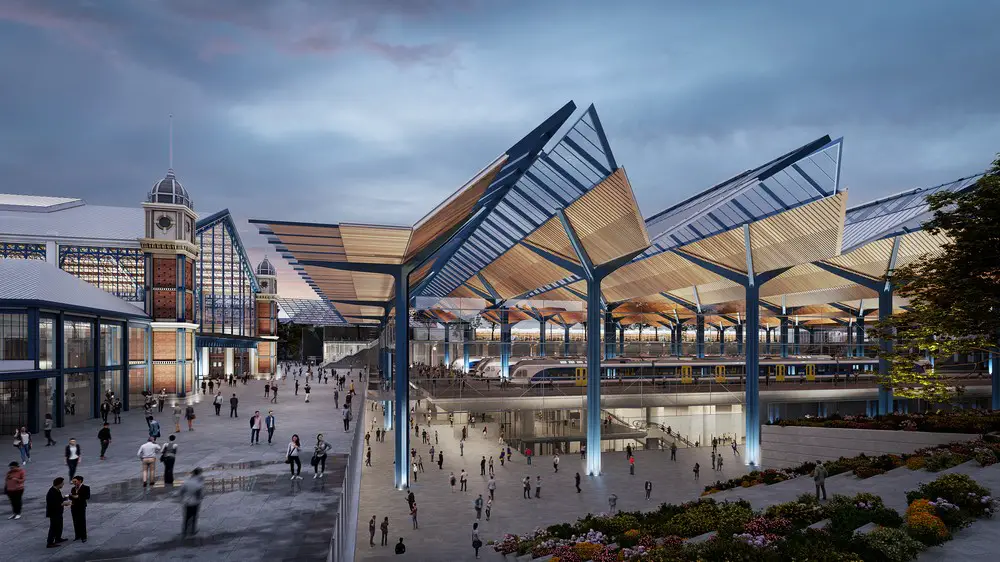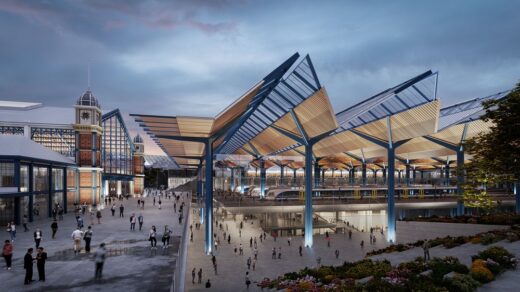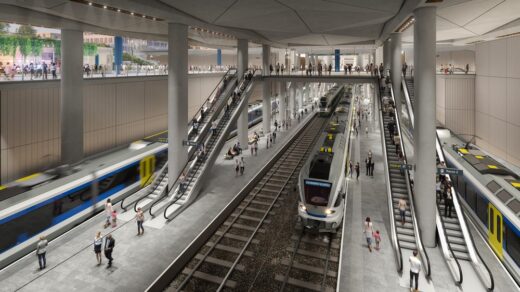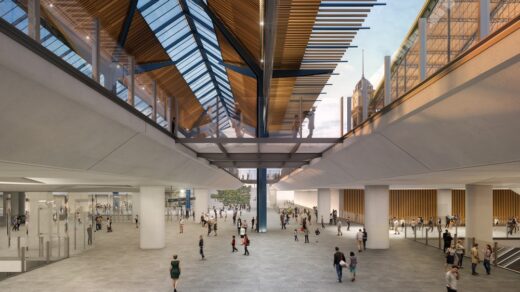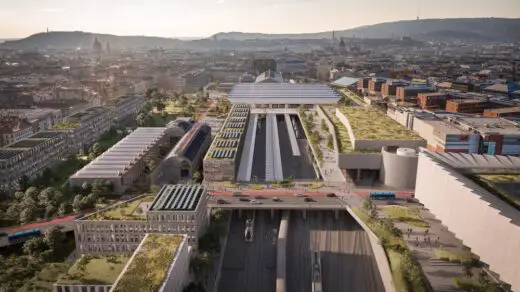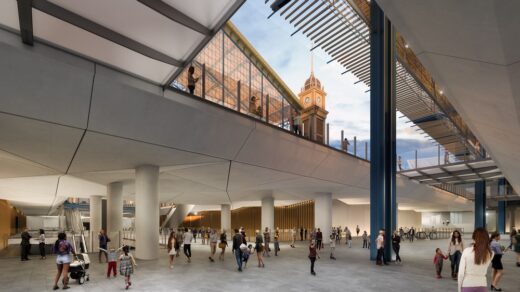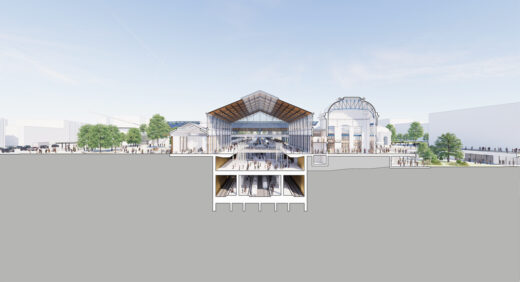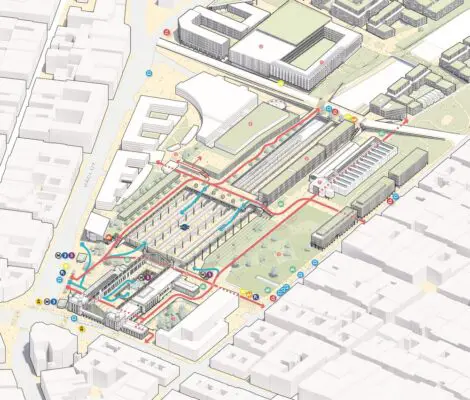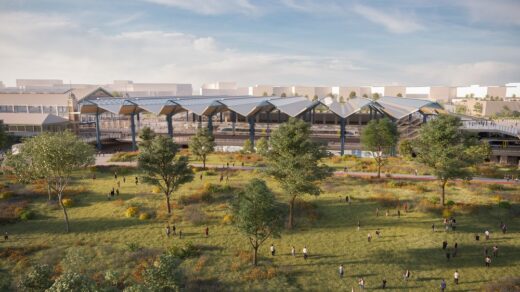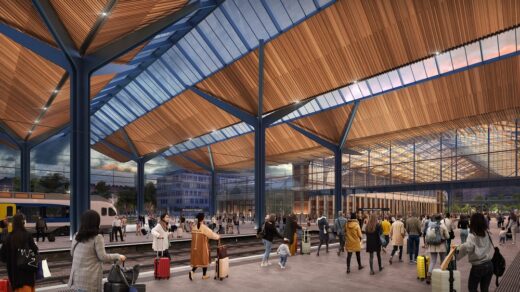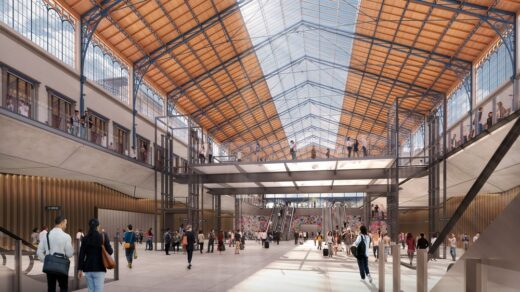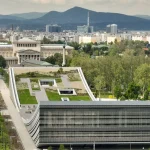Nyugati Railway Station Hungary, Budapest Building Renewal, Hungarian Architecture Competition Winners
Nyugati Railway Station in Budapest
29 Mar 2022
Design: Grimshaw
Location: Budapest, Hungary
Nyugati Railway Station, Hungary
International architecture practice Grimshaw, has been awarded first place in the competition for the renewal of Budapest Nyugati Railway Station. The winning design, in collaboration with Nautes Architects, WSP, Vogt and Turner & Townsend, was selected, as part of an anonymous competition, from a shortlist of 12 internationally recognised teams. Neill McClements, Partner at Grimshaw, accepted the award at a ceremony in Budapest on Saturday 26 March 2022.
Guided by the principles of the competition – to increase the capacity of the existing station, preserve the heritage of the Eiffel Hall, and connect the station to the city by injecting a ‘new lease of life’ to the surrounding area – the winning concept design creates a permeable station ‘campus’. A series of car-free streets, walkways, squares and a public park opens up the station complex to the city and draws passengers and public to this ‘new’ city quarter: restoring its local and international significance situated in one of the most vibrant and historic cities in Europe.
With the area severed by the railway corridor since the late 19th century, the concept masterplan integrates new pedestrian routes across the site and the underground station. A new boulevard connects Lehel Tér in the west to Kodály Körönd to the east, rising above the railway via a new bridge, and the existing Ferdinand Bridge is rebuilt and realigned.
Running north from Nyugati Tér, another pedestrian route connects to the proposed conference centre. And east and west of the site further networks are created by a new link bridge spanning centrally over the surface station. These routes connect people, through public spaces, to existing and identified opportunity sites around the station: to the north-east, a new residential area on Podmaniczky Utca is proposed while to the north-west, routes connect people to the proposed conference and new residential and retail destination.
The judges of the competition commented: “One of the main virtues of the submission is the creation of transparent, open, permeable, human-scale spaces that provide complex connections through logical lines.”
Central to the concept is the guardianship and celebration of the protected Eiffel Hall which is integrated with new subsurface station and surrounding landscape. Preserving the historical significance of this 14,000 sqm building, the design repositions Eiffel Hall as a pedestrian public hall – celebrating the grandeur of arrival and departure from Budapest – and incorporates cafés, a food hall and bookshop at ground level with central escalators guiding passengers to the extended tracks below ground. These tracks will, in future, receive trains from Buda via the future planned railway tunnel under the river Danube. The restoration of the Hall includes the integration of new entrance porticos to the east and west flank elevations.
To the north-east of the Eiffel Hall is the new station arcade, which sensitively celebrates railway engineering with an elegant long span roof structure soaring over the surface level station. This structure, creating a new entrance to the station on Podmaniczky Utca and the new Linear Park floods the internal space with natural light, and adopts natural materials to further connect the station to its city surroundings, as well as providing a vibrant space for passengers.
Circulation and openings between the levels of the new station arcade and the Eiffel Hall also serve to bring natural light deep into the underground spaces with visual connections to the Hall and Linear Park enhancing and elevating the intuitive wayfinding for interchanging passengers. Drawing the two structures together and creating a human scale to the site is a newly created pedestrian walkway – Eiffel Passage – which connects passengers across the station campus.
Knitting the whole concept together is the approach to the urban realm and landscape. To the south a series of spaces blur the boundaries between the city and the station. A 3.5-hectare Linear Park along Podmaniczky Utca sits alongside the new station arcade and accommodates local uses including a football pitch and dog park. And with an approach of reuse and repurposing existing structures over new build, the Motor Hall within the park is sensitively restored with a proposal to be reused as a cultural and leisure facility. To the west of the Linear Park a new station square and a revitalised, pedestrian-friendly Nyugati square – the primary arrival points for the station – pushes cars to the periphery of the site enabling micromobility across the station campus.
“Central to our design concept is guardianship of heritage, adaptive reuse and humanising of the passenger journey.” says Mark Middleton Partner at Grimshaw, “The approach developed through a collaboration of our London and Sydney studios and with local and international consultants, is one which protects and preserves the heritage of Nyugati Station and places its 21st century life firmly in the aesthetic of a civic space. Travel for passengers will no doubt be enhanced, but in parallel a new, revived destination for this beautiful, historic city will be created. We are incredibly honoured to be selected as the winners of the competition and look forward to working with the Budapest Development Agency to deliver the design and construction of the station in the coming years.”
Saint Gellért Hall in Budapest, Hungary – Building Information
Team:
Architect: Grimshaw – https://grimshaw.global/
Supported by:
Local architect: Nautes Építészműterem Kft – www.nautes.hu
Landscape Architects: Vogt
Engineering: WSP
Cost & project management: Turner & Townsend
The competition was judged by a jury led by:
Balázs Fürjes, State Secretary for the Development of Budapest and its Agglomeration – Chair
Zsolt Füleky, Deputy State Secretary for Architecture, Construction and Heritage Protection – Co-Chair
Dávid Vitézy, CEO of Budapest Development Agency (BFK) – Co-Chair
Further information on the competition: nyugatidesigncompetition.com – inactive when checked on 10 November 2023
https://bfk.hu/grimshaw-win-competition-for-the-nyugati-railway-station-in-budapest/
About Grimshaw
Grimshaw is an international architectural practice delivering buildings, infrastructure and places that are underpinned by the principles of humane, enduring, sustainable design. With offices in New York, Los Angeles, London, Paris, Dubai, Melbourne and Sydney, Grimshaw employs over 600 staff. The practice’s international portfolio covers all major sectors and has been honoured with over 200 international design awards.
Nyugati Railway Station, Budapest Building images / information received 290322
Location: Budapest, Hungary, central eastern Europe
Budapest Architecture
Budapest Architecture Designs
Paris Court
Design: building renovation by KROKI and architecture studio ARCHIKON
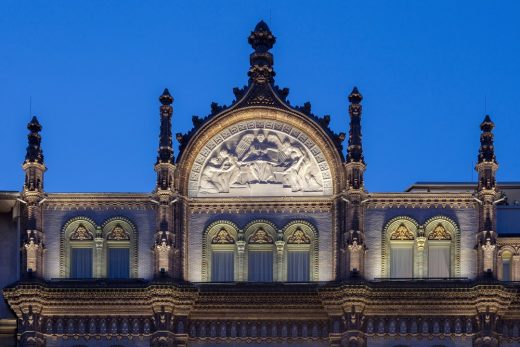
photo : Tamás Bujnovszky
Paris Court Budapest
The Duna Arena
Design: NAPUR Architect
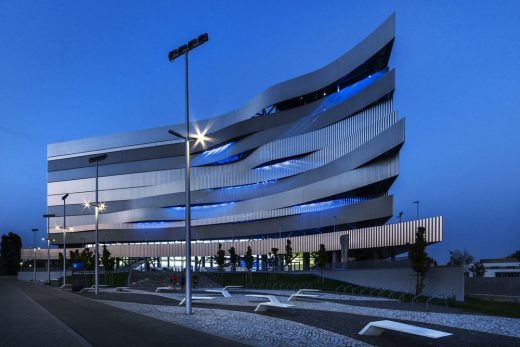
photo © Tamás Bujnovszky
The Duna Arena in Budapest
Budapest M4 Metro Station Buildings
Design: Palatium Studio architects
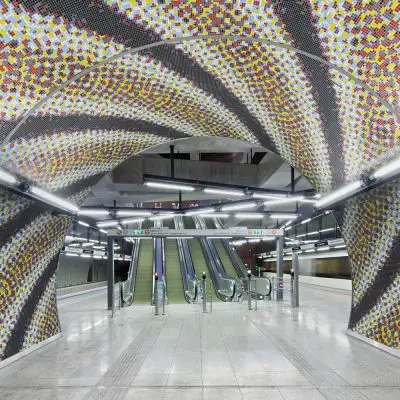
photo © Tamás Bujnovszky
Budapest M4 Metro Station Buildings
Hungarian Autoklub Headquarters
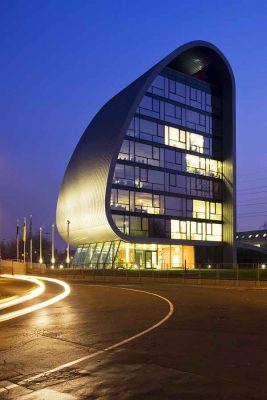
photograph © Tamás Bujnovszky
Hungarian Autoklub Headquarter
Budapest Architecture Walking Tours
Hello Wood Festival Designs
Hello Wood International Summer University and Festival
Nepsziget Budapest Masterplan
Nepsziget Budapest Masterplan
Hungarian Architect – architectural firm listings on e-architect
Comments / photos for the Nyugati Railway Station, Budapest Building Architecture design by Grimshaw page welcome

